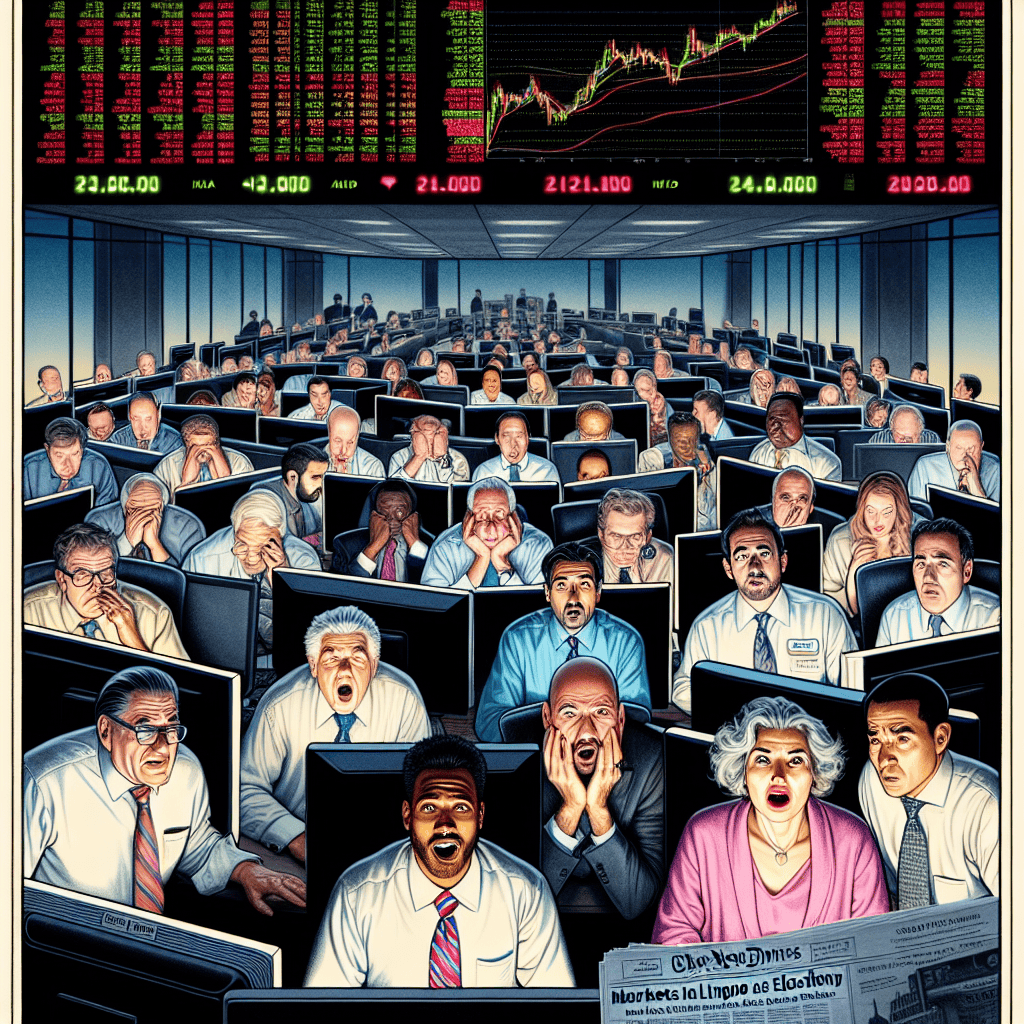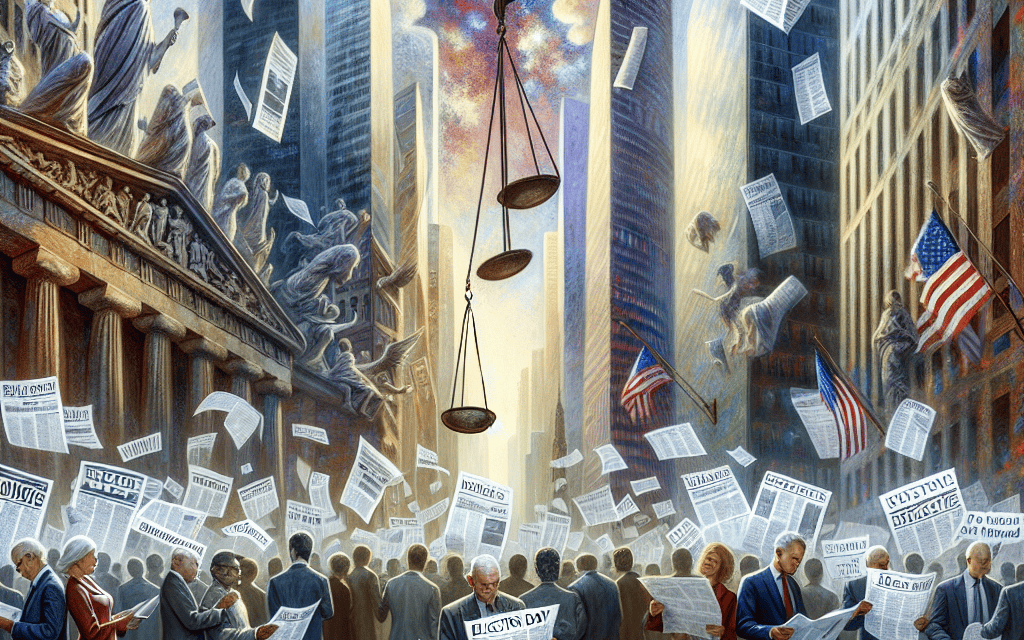“Markets in Limbo: Wall Street Holds Its Breath for Election Day Outcomes”
Introduction
As Election Day looms, Wall Street finds itself in a state of uncertainty, with markets teetering in anticipation of the electoral outcomes. Investors are navigating a landscape fraught with volatility, as the potential for significant policy shifts hangs in the balance. The financial sector is acutely aware that the results could herald changes in regulatory frameworks, tax policies, and government spending, all of which have profound implications for market dynamics. This period of limbo is characterized by cautious trading and strategic positioning, as market participants brace for the impact of the election’s resolution on economic and financial stability.
Impact Of Election Uncertainty On Stock Market Volatility
As Election Day approaches, the financial markets find themselves in a state of heightened anticipation and uncertainty. This period, often characterized by increased volatility, reflects the broader economic and political anxieties that accompany major electoral events. Investors, analysts, and policymakers alike are keenly aware of the potential implications that election outcomes can have on fiscal policies, regulatory environments, and international relations. Consequently, the stock market becomes a barometer of sentiment, reacting to the ebb and flow of electoral developments.
Historically, the period leading up to an election is marked by a discernible increase in market volatility. This is largely due to the uncertainty surrounding potential shifts in government policies that could impact various sectors differently. For instance, industries such as healthcare, energy, and finance are particularly sensitive to changes in regulatory frameworks and government spending priorities. As candidates outline their platforms, market participants attempt to forecast the potential winners and losers, leading to fluctuations in stock prices as they adjust their portfolios accordingly.
Moreover, the uncertainty is not confined to domestic policies alone. The outcome of an election can also influence international trade agreements, foreign policy stances, and global economic partnerships. This interconnectedness means that global markets are also attuned to the developments on Wall Street, with international investors closely monitoring the situation. The anticipation of potential changes in trade policies or diplomatic relations can lead to shifts in global market dynamics, further contributing to the volatility experienced during this period.
In addition to policy considerations, the psychological aspect of market behavior cannot be overlooked. Investor sentiment plays a crucial role in driving market movements, and during times of uncertainty, emotions such as fear and optimism can lead to exaggerated market reactions. The media’s coverage of the election, including opinion polls and debates, can amplify these emotions, leading to increased trading volumes and price swings. This phenomenon underscores the importance of investor psychology in understanding market volatility during election cycles.
Furthermore, the role of technology and algorithmic trading has added another layer of complexity to market dynamics. High-frequency trading algorithms, which are designed to capitalize on short-term market movements, can exacerbate volatility by executing large volumes of trades in response to news events. This can lead to rapid price changes and increased market instability, particularly in the absence of clear election outcomes.
As Election Day draws nearer, market participants are advised to exercise caution and maintain a long-term perspective. While short-term volatility is inevitable, historical data suggests that markets tend to stabilize once election results are confirmed and policy directions become clearer. Investors are encouraged to focus on fundamental analysis and diversify their portfolios to mitigate risks associated with election-related uncertainties.
In conclusion, the period leading up to an election is a time of heightened market volatility, driven by uncertainties surrounding potential policy changes and investor sentiment. As Wall Street awaits the results, the interplay of domestic and international factors, coupled with technological advancements in trading, contributes to the complex landscape of market dynamics. By understanding these elements, investors can better navigate the challenges and opportunities presented by this critical juncture in the electoral cycle.
Historical Analysis: How Past Elections Have Influenced Market Trends
As Wall Street braces for the impending results of the upcoming election, investors and analysts alike are keenly aware of the historical patterns that have shaped market trends during past election cycles. The intersection of politics and economics has long been a subject of intense scrutiny, with elections often serving as pivotal moments that can either bolster or unsettle market confidence. To understand the potential implications of the current electoral climate, it is instructive to examine how previous elections have influenced market behavior.
Historically, the stock market has exhibited a tendency to experience heightened volatility in the months leading up to an election. This phenomenon can be attributed to the uncertainty surrounding potential policy shifts that may accompany a change in administration. Investors, wary of the unknown, often adopt a cautious approach, leading to fluctuations in market indices. For instance, the 2000 presidential election, marked by the contentious Bush-Gore contest, saw the S&P 500 endure significant volatility as the nation awaited a resolution to the electoral impasse. Similarly, the 2016 election, which culminated in a surprise victory for Donald Trump, initially triggered a sharp decline in futures markets, only to be followed by a rapid recovery as investors recalibrated their expectations in light of anticipated pro-business policies.
Moreover, the market’s response to election outcomes is not solely dictated by the identity of the victor but also by the broader political landscape, including the composition of Congress. A divided government, where different parties control the executive and legislative branches, often results in legislative gridlock, which can be perceived as either a stabilizing force or a source of frustration, depending on the prevailing economic conditions. For example, during the Obama administration, periods of divided government were characterized by contentious budget negotiations and debt ceiling standoffs, which occasionally rattled markets. Conversely, some investors view gridlock as a safeguard against radical policy shifts, thereby providing a measure of predictability.
In addition to the immediate aftermath of an election, the long-term market trajectory is influenced by the policies enacted by the incoming administration. Tax reforms, regulatory changes, and fiscal policies are among the key factors that can shape economic growth and investor sentiment. The Reagan era, for instance, was marked by significant tax cuts and deregulation, which contributed to a prolonged bull market. In contrast, the early years of the Obama administration, grappling with the aftermath of the financial crisis, saw a focus on regulatory reform and stimulus measures, which had a mixed impact on market performance.
While historical patterns offer valuable insights, it is crucial to acknowledge that each election cycle is unique, shaped by its own set of economic, social, and geopolitical factors. The current election, occurring amidst a backdrop of global economic uncertainty and shifting geopolitical dynamics, presents its own set of challenges and opportunities. As such, investors must remain vigilant, balancing historical precedents with contemporary realities.
In conclusion, while past elections provide a framework for understanding potential market reactions, the inherent unpredictability of political outcomes necessitates a cautious and adaptive approach. As Wall Street awaits the results of the current election, the lessons of history serve as both a guide and a reminder of the complex interplay between politics and markets. Ultimately, the ability to navigate this uncertainty will be crucial for investors seeking to capitalize on the opportunities that lie ahead.
Investor Strategies During Political Uncertainty
As Election Day approaches, investors find themselves navigating a landscape fraught with uncertainty. The anticipation of potential shifts in political power and policy direction has left markets in a state of limbo, with many investors unsure of how to position their portfolios. In such times, it becomes crucial to adopt strategies that can mitigate risk while still allowing for potential gains. Understanding the dynamics at play and the historical context of market behavior during election cycles can provide valuable insights for investors seeking to make informed decisions.
Historically, markets have exhibited volatility in the lead-up to elections, often reacting to the perceived implications of different electoral outcomes. This volatility is driven by the uncertainty surrounding potential changes in fiscal policy, regulatory environments, and international relations. Investors, therefore, must remain vigilant and adaptable, recognizing that the market’s response to election results can be swift and significant. In this context, diversification emerges as a key strategy. By spreading investments across various asset classes, sectors, and geographies, investors can reduce exposure to any single source of risk. This approach not only helps in cushioning against potential downturns but also positions portfolios to capitalize on opportunities that may arise from unexpected election outcomes.
Moreover, maintaining a long-term perspective is essential during periods of political uncertainty. While short-term market fluctuations can be unsettling, it is important to remember that markets have historically rebounded from election-related volatility. By focusing on long-term goals and maintaining a disciplined investment approach, investors can avoid making impulsive decisions based on temporary market movements. This strategy is particularly relevant in the current environment, where the global economy is still recovering from the impacts of the COVID-19 pandemic. The interplay between election results and ongoing economic recovery efforts will likely influence market trajectories, making it imperative for investors to stay the course and not be swayed by short-term noise.
In addition to diversification and a long-term outlook, investors should also consider the role of defensive assets in their portfolios. Assets such as bonds, gold, and other commodities can provide a hedge against market volatility and serve as a stabilizing force during uncertain times. These assets tend to perform well when equity markets are under pressure, offering a counterbalance to potential losses in riskier investments. Furthermore, investors might explore opportunities in sectors that are less sensitive to political changes, such as consumer staples and healthcare, which often exhibit resilience regardless of the prevailing political climate.
As Election Day draws nearer, it is also prudent for investors to stay informed about the potential policy implications of different electoral outcomes. Understanding the platforms and proposed policies of candidates can help investors anticipate which sectors might benefit or suffer from changes in government priorities. For instance, shifts in tax policy, infrastructure spending, or environmental regulations could have significant impacts on specific industries. By staying abreast of these developments, investors can make more informed decisions about where to allocate their resources.
In conclusion, while political uncertainty can pose challenges for investors, it also presents opportunities for those who are prepared. By employing strategies such as diversification, maintaining a long-term perspective, incorporating defensive assets, and staying informed about policy implications, investors can navigate the complexities of election cycles with greater confidence. As markets remain in limbo awaiting Election Day results, these strategies can provide a framework for managing risk and positioning portfolios for future success.
The Role Of Economic Indicators In Pre-Election Market Behavior

As Election Day approaches, the financial markets find themselves in a state of uncertainty, a condition that is not uncommon during such politically charged periods. Investors, analysts, and policymakers alike are keenly observing economic indicators to gauge potential market behavior in the lead-up to the election results. These indicators, which include employment rates, consumer confidence, and GDP growth, serve as vital tools in understanding the economic landscape and predicting market trends. However, the interpretation of these indicators can be complex, especially when political factors are at play.
To begin with, employment rates are often scrutinized as a measure of economic health. A robust job market typically signals economic strength, which can bolster investor confidence. In the months leading up to an election, a declining unemployment rate might be perceived as a positive sign for the incumbent party, potentially stabilizing markets. Conversely, rising unemployment could lead to market volatility, as investors may anticipate policy changes from a potential new administration. Thus, employment data can significantly influence market sentiment during this period.
In addition to employment figures, consumer confidence is another critical economic indicator that can impact pre-election market behavior. Consumer confidence reflects the overall economic outlook from the perspective of households, influencing spending and investment decisions. High consumer confidence suggests that individuals are optimistic about their financial future, which can lead to increased spending and, consequently, economic growth. This optimism can translate into bullish market behavior as investors anticipate continued economic expansion. On the other hand, a dip in consumer confidence might signal economic uncertainty, prompting cautious market behavior as investors brace for potential downturns.
Moreover, GDP growth is a comprehensive indicator of economic performance that investors closely monitor. Strong GDP growth indicates a thriving economy, which can be reassuring for markets. In the context of an election, robust GDP figures may be interpreted as a validation of current economic policies, potentially leading to market stability. However, if GDP growth is sluggish or negative, it could raise concerns about the effectiveness of existing policies, thereby increasing market volatility as investors speculate on possible policy shifts post-election.
While these economic indicators provide valuable insights, it is essential to recognize that their impact on pre-election market behavior is not solely deterministic. Political factors, such as campaign promises, debates, and public opinion polls, also play a significant role in shaping market expectations. For instance, if a candidate proposes policies that are perceived as business-friendly, markets may react positively, even if economic indicators suggest otherwise. Conversely, proposals that are viewed as potentially disruptive to business operations could lead to market apprehension.
In conclusion, as Wall Street awaits the results of Election Day, economic indicators serve as crucial tools for understanding and predicting market behavior. Employment rates, consumer confidence, and GDP growth offer insights into the economic landscape, helping investors navigate the uncertainty that often accompanies elections. However, it is important to consider these indicators in conjunction with political developments, as the interplay between economic data and political dynamics ultimately shapes market outcomes. As such, investors must remain vigilant, continuously assessing both economic and political factors to make informed decisions during this period of limbo.
Sector-Specific Reactions To Election Outcomes
As Election Day approaches, Wall Street finds itself in a state of uncertainty, with markets exhibiting a cautious stance as investors brace for potential shifts in policy that could significantly impact various sectors. The anticipation surrounding the election results has led to a palpable tension, as market participants attempt to navigate the complexities of potential policy changes that could arise from a new administration or a shift in congressional power. This uncertainty is particularly pronounced in sectors that are highly sensitive to regulatory and fiscal policy changes, such as healthcare, energy, and technology.
In the healthcare sector, the election outcomes could have profound implications. A shift in political power could lead to changes in healthcare policy, including potential reforms to the Affordable Care Act or the introduction of new healthcare initiatives. Investors are closely monitoring the potential for increased regulation or changes in drug pricing policies, which could impact pharmaceutical companies and healthcare providers. The sector’s performance is likely to be influenced by the election results, as different political parties have divergent views on healthcare reform and regulation.
Similarly, the energy sector is on high alert as it awaits the election outcomes. The sector’s future is closely tied to environmental policies and regulations, which can vary significantly depending on the political landscape. A government that prioritizes renewable energy and environmental protection could lead to increased investment in clean energy technologies, while a focus on traditional energy sources could bolster the oil and gas industry. The election results could thus determine the direction of energy policy, influencing the sector’s long-term growth prospects and investment strategies.
The technology sector, too, is poised for potential changes depending on the election results. Issues such as data privacy, antitrust regulations, and international trade policies are at the forefront of concerns for tech companies. A shift in political power could lead to stricter regulations on tech giants, impacting their operations and profitability. Additionally, changes in trade policies could affect the global supply chains that many technology companies rely on, further adding to the sector’s uncertainty.
Moreover, the financial sector is not immune to the potential impacts of the election. Regulatory changes, tax policies, and fiscal stimulus measures are all factors that could be influenced by the election outcomes. Financial institutions are particularly sensitive to changes in interest rates and regulatory frameworks, which can affect their lending practices and profitability. As such, the sector is closely watching the election results to gauge the potential for shifts in economic policy that could impact their operations.
In conclusion, as Wall Street awaits the election results, markets remain in a state of limbo, with sector-specific reactions hinging on the potential for policy changes. The healthcare, energy, technology, and financial sectors are particularly sensitive to the election outcomes, as they stand to be significantly impacted by shifts in regulatory and fiscal policies. Investors are keenly aware of the potential for volatility and are preparing for a range of scenarios that could unfold post-election. As the nation heads to the polls, the anticipation of the results underscores the intricate relationship between politics and market dynamics, highlighting the importance of understanding sector-specific reactions to election outcomes.
Comparing Domestic And Global Market Responses To U.S. Elections
As the United States approaches another pivotal election day, the financial markets find themselves in a state of uncertainty, a phenomenon not unfamiliar to seasoned investors. Historically, U.S. elections have had a profound impact on both domestic and global markets, with investors closely monitoring the potential shifts in economic policy that could follow a change in administration. This year is no exception, as Wall Street braces for the election results, with market participants keenly aware of the implications for fiscal policy, regulatory changes, and international trade agreements.
Domestically, the U.S. stock market often experiences heightened volatility in the weeks leading up to an election. Investors tend to adopt a cautious approach, with many opting to hold off on significant investment decisions until the political landscape becomes clearer. This cautious sentiment is reflected in the fluctuating stock prices and trading volumes, as market participants attempt to hedge against potential risks. The uncertainty surrounding the election outcome can lead to a temporary slowdown in market activity, as investors weigh the potential impacts of different policy agendas on sectors such as healthcare, energy, and technology.
In contrast, global markets respond to U.S. elections with a different set of considerations. While domestic markets are primarily concerned with internal policy changes, international investors focus on the potential shifts in U.S. foreign policy and trade relations. The United States, being a major player in the global economy, influences international markets through its economic policies and diplomatic relations. Consequently, global markets often react to U.S. elections with a mix of anticipation and apprehension, as countries assess how the election results might affect their economic ties with the U.S.
Moreover, the interconnectedness of global financial systems means that volatility in U.S. markets can quickly ripple across the world. For instance, a significant drop in U.S. stock prices can lead to a sell-off in international markets, as investors seek to mitigate their exposure to risk. Conversely, a positive market reaction in the U.S. can bolster investor confidence globally, leading to a rally in international markets. This interdependence underscores the importance of U.S. elections not only for domestic investors but also for the global financial community.
In addition to these market dynamics, currency fluctuations are another critical aspect of how global markets respond to U.S. elections. The U.S. dollar, as the world’s primary reserve currency, plays a crucial role in international trade and finance. Election outcomes that signal potential changes in U.S. economic policy can lead to shifts in currency valuations, impacting global trade balances and investment flows. For instance, a perceived increase in economic stability following an election might strengthen the dollar, while uncertainty or anticipated policy shifts could weaken it.
In conclusion, as Wall Street awaits the results of the upcoming U.S. election, both domestic and global markets remain in a state of limbo. The anticipation of potential policy changes and their subsequent impact on various sectors creates an environment of uncertainty that is reflected in market behavior. While domestic markets focus on internal policy implications, global markets are attuned to shifts in U.S. foreign policy and trade relations. This intricate interplay between domestic and global market responses highlights the far-reaching influence of U.S. elections on the financial landscape, underscoring the importance of these events for investors worldwide. As the election day approaches, market participants will continue to navigate this uncertainty, seeking to position themselves advantageously in anticipation of the election’s outcome.
Expert Predictions: Post-Election Market Scenarios And Opportunities
As Election Day looms, Wall Street finds itself in a state of uncertainty, with investors eagerly anticipating the results that could significantly influence market dynamics. The financial markets are often sensitive to political shifts, and the upcoming election is no exception. Experts are closely analyzing potential post-election scenarios, each carrying its own set of opportunities and challenges for investors. Understanding these possibilities is crucial for those looking to navigate the markets effectively in the coming months.
One potential scenario involves a clear and decisive election outcome, which could provide a sense of stability and predictability to the markets. Historically, markets tend to favor certainty, and a definitive result could lead to a rally as investors gain confidence in the political landscape. In this case, sectors that are sensitive to regulatory changes, such as healthcare and energy, might experience significant movements. Investors may find opportunities in these sectors, particularly if the election results align with policies that favor growth and innovation.
Conversely, a contested election or prolonged uncertainty could lead to increased market volatility. In such a scenario, investors might witness sharp fluctuations as the markets react to the lack of clarity. This environment could present opportunities for those skilled in short-term trading, as volatility often creates price discrepancies that can be exploited. However, it also necessitates a cautious approach, as the risks associated with unpredictable market movements are heightened. Diversification and risk management strategies become paramount in navigating such turbulent times.
Moreover, the election results could have profound implications for fiscal policy, which in turn would impact economic growth and market performance. A government inclined towards increased spending and stimulus measures might boost consumer confidence and drive economic expansion. This could benefit sectors such as consumer goods and infrastructure, where increased government spending could lead to higher demand and profitability. On the other hand, a focus on austerity and budget cuts might lead to a more conservative market outlook, with investors gravitating towards defensive sectors like utilities and consumer staples.
In addition to domestic policies, the election outcome could also influence international relations and trade policies, further affecting market dynamics. A government that prioritizes international cooperation and trade agreements might bolster global markets and enhance opportunities for multinational corporations. Conversely, a more protectionist stance could lead to trade tensions and impact sectors reliant on global supply chains. Investors with a keen eye on international markets should consider these factors when evaluating potential investment opportunities.
Furthermore, the election results could shape monetary policy, particularly in relation to interest rates and inflation. A government focused on economic growth might support policies that keep interest rates low, encouraging borrowing and investment. This could benefit sectors such as real estate and technology, where low borrowing costs can drive expansion and innovation. However, concerns about inflation could lead to a tightening of monetary policy, impacting sectors sensitive to interest rate changes, such as financials and real estate.
In conclusion, the upcoming election presents a myriad of potential scenarios for the financial markets, each with its own set of opportunities and challenges. Investors must remain vigilant and adaptable, carefully considering the implications of the election results on various sectors and market dynamics. By staying informed and employing strategic investment approaches, investors can position themselves to capitalize on the opportunities that arise in the post-election landscape, regardless of the outcome.
Q&A
1. **What is the main concern for markets as Election Day approaches?**
– Markets are primarily concerned about the uncertainty surrounding the election results and the potential for a contested outcome, which could lead to increased volatility.
2. **How are investors preparing for potential election-related volatility?**
– Investors are hedging their portfolios by increasing cash positions, investing in safe-haven assets like gold and government bonds, and using options strategies to protect against downside risk.
3. **What sectors are most likely to be affected by the election results?**
– Sectors such as healthcare, energy, and technology could see significant impacts depending on the election outcome, as different policies could affect regulation and taxation.
4. **How has historical election uncertainty impacted the markets?**
– Historically, markets have experienced increased volatility and cautious trading in the weeks leading up to an election, with potential for sharp movements once results are clear.
5. **What role does fiscal policy play in market expectations during election periods?**
– Fiscal policy, including potential stimulus measures, is a key focus for markets, as it can influence economic growth prospects and corporate earnings.
6. **How are global markets reacting to the U.S. election uncertainty?**
– Global markets are also experiencing volatility, as the U.S. election outcome can have significant implications for international trade, foreign policy, and global economic stability.
7. **What are analysts predicting for market behavior post-election?**
– Analysts predict that markets may stabilize once there is clarity on the election results, but the extent of the recovery or further volatility will depend on the policy directions of the new administration.
Conclusion
The uncertainty surrounding election outcomes often leads to market volatility, as investors grapple with potential policy changes and economic impacts. In the period leading up to Election Day, markets typically experience heightened sensitivity to news and speculation, resulting in fluctuating stock prices and trading volumes. This state of limbo reflects the broader uncertainty in the financial landscape, as market participants await clarity on future political and economic directions. Once election results are finalized, markets generally stabilize as investors adjust their strategies based on the anticipated policy environment.





